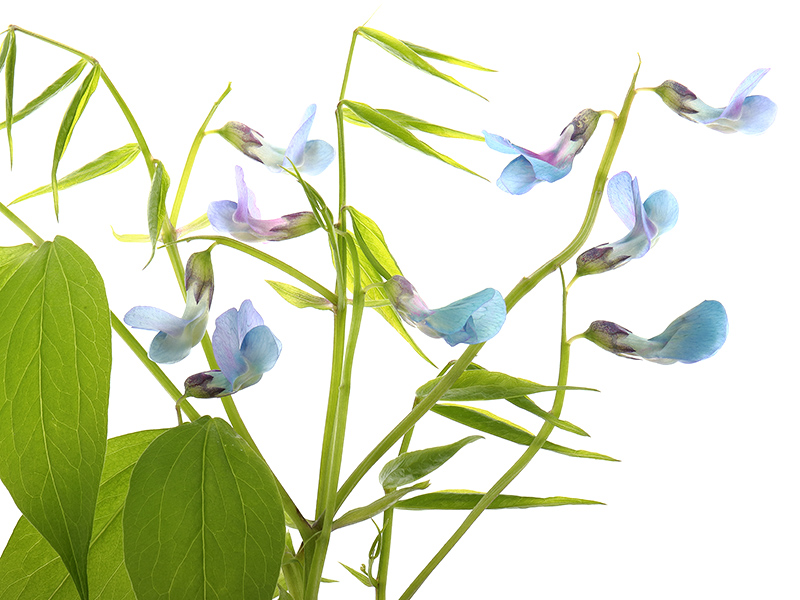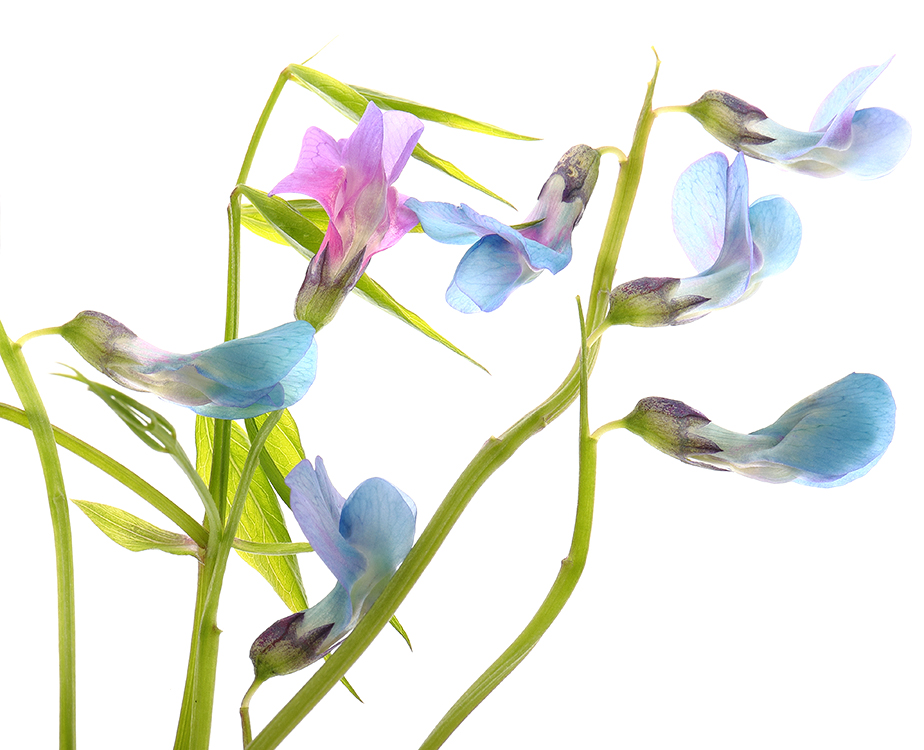Last month I photographed these tiny spring pea (Lathyrus vernus) flowers. After I had finished photographing them I noticed that they were still changing colour after they had been picked.
The flowers had started off as a purple-pink but were changing to blue as they aged. I wondered if they would turn entirely blue and I found, after a couple of days, that almost all of them had. (As you can see, there is one flower that has stubbornly managed to remain pink in the top photograph. However, I reckon it would have turned blue too if it had been able to last long enough.)
Having flowers that change colour is a bonus for a photographer, allowing a whole new set of photographs to be made of the same subject. It’s also fascinating to watch as this happens.
Apparently the reasons for this kind of colour change are practical. It lets pollinating insects know that the individual flower has already been pollinated and will now have little pollen or nectar left to offer them. This helps the plant by directing the attention of pollinators to those other flowers that are still waiting to be pollinated.
Colour change happens in other plants too. The one that I’m most aware of at the moment is Salvia ‘Hot Lips’. That’s because I bought what I thought was an un-labelled sage with a good bright red flower which would be ideal for an area of planting with hot colours. (I already had the magenta-flowered Salvia microphylla, which flowers really well here. This looked like a red version of it.)
I was a bit surprised later on, when the new flowers on the plant began opening in the well-known red and white bicolours of Hot Lips. From what I’ve read, the flowers on this plant can be red, bicoloured, or white, depending on temperature or growing conditions. So it’s an interesting plant to watch but not so useful if you have a particular colour scheme in mind!
Colour change isn’t something I’ve been much aware of in the past. But now it has me intrigued and I can see that it may give me good photographic opportunities too. So I’ll be keeping an eye open for other plants that do this…there’s always something interesting happening in gardens!
You can see my post with the spring peas still in their original pinks and purples here.


This is a particularly beautiful example of the colour change phenomenon!
LikeLiked by 1 person
Thank you Liz! It has sent me off on a new quest to find other flowers that change colour… 🙂
LikeLiked by 1 person
Fantastic .. I’m looking forward to seeing what you find!
LikeLiked by 1 person
Wonderful information, Ann! Lovely pictures!!
LikeLiked by 1 person
Thank you Indira! If I can find other flowers that change colour I will have more photographic opportunities, so I’m on the lookout! 🙂
LikeLiked by 1 person
How gorgeous! Looks like a watercolour. My Graham Thomas roses fade to a pale lemon from deep yellow. I wondered if the change of colour informed the pollinators not to bother visiting!
LikeLiked by 1 person
It would be really interesting to know. I’m guessing that if flowers fade as they age, bees are likely to be aware of that so that they can go to the fresher flowers with more pollen and nectar. Nature is clever! 🙂
LikeLike
I’ve seen this happen with a few wildflowers. The only one that comes to mind is forget-me-nots but I know I have seen a few others.
LikeLiked by 1 person
And the change in forget-me-nots reminds me that borage can change too – there’s a great video here that shows the flower opening pink and then gradually turning blue: https://www.youtube.com/watch?v=iRomNH5tvJA
LikeLiked by 1 person
Thanks for the link, Ann. Amazing what happens in Nature. ::-)
LikeLiked by 1 person
Goodness me, that is different and interesting. Useful fact about the warning to pollinators.
LikeLiked by 1 person
Nature is amazing – and it makes sense for the plant to persuade the bees to go where it needs them. 🙂
LikeLiked by 1 person
How interesting! Love the fact that they change colors to let the bees know not to bother them again. It never occurred to me that this happens in nature. Love the image also. Sounds like you may be in for a few surprises this summer in your garden!
LikeLiked by 1 person
I think the relationships between flowers and the insects that pollinate them that have evolved over time into something very complex – amazing nature! 🙂
LikeLike
I also learned something new today, Ann. I will keep my eyes open and hope to observe this phenomenon myself.
By the way, I love the name Salvia Hot Lips. It screams “Come and pollinate me” to the insects. 💋🦋
LikeLiked by 1 person
It was new for me too, so I’ll be looking for more. Hot Lips sounds like a bit of a naughty girl to me, LOL!
LikeLiked by 1 person
Yes, to me, too. And she is ready to have some fun with those pollinators. 🙂
LikeLiked by 1 person
Hehe!
LikeLiked by 1 person
One of the most common examples of color change involves our bluebonnets. The banner on each individual flower changes from white to red as a signal to the pollinators that they need to move on. Another one here is Tephrosia onobrychoides. I have some photos I can’t lay my hands on right now, but here’s what they look like. It’s interesting that the change with them is from white to red, too. If there are Tephrosia species in your area, that would be one avenue for exploration. Since bluebonnets change, perhaps some of your lupines do, too.
LikeLiked by 1 person
That’s a great colour change – makes it easy for the bees. I have previously read that bees are less interested in red as a flower colour, so maybe that’s the reason – I’m intrigued! 🙂
LikeLike